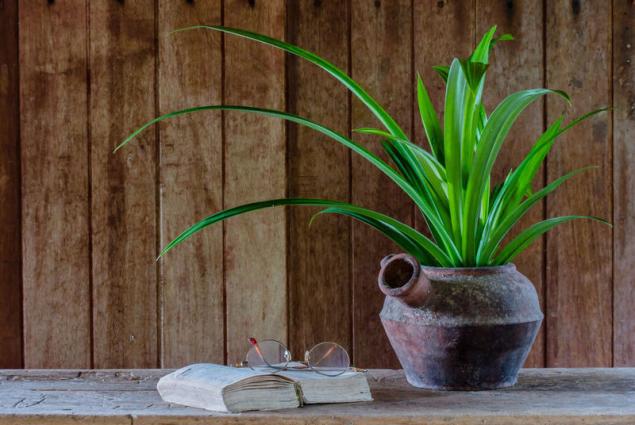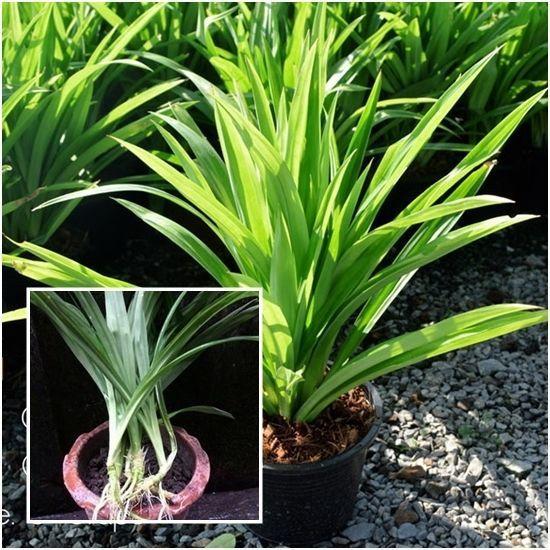599
How to care for pandanus in the home
This species is quite often seen in indoor environment, and all thanks to the decorative effect of its leaves. The pandanus matched each narrow, dark green leaves decorated with contrasting longitudinal white stripes. Themselves the leaves of the adult plant reach a length of about 1 meter.
Pandanus in the natural conditions
The genus Pandanus (Pandanus) belongs to the family Pandamovie, and includes about 600 species. Natural areola habitat of this genus Australia, Southeast Asia and the Pacific Islands. In natural conditions plants represent a tree of trees or vines, evergreen, they grow up to 15 meters in height. There are plants in appearance resembling a lush Bush.

As a rule, all plant species form aerial roots, which not just fulfills the function of the roots, and serve as a support for plants.
The leaves and plants of this species resemble the shape of the leaves of dracaena, they are ensiform shape. But unlike the leaves of the dracaena leaves of pandanus tougher and the edge is covered with very sharp notches. In most plants the leaves of this species grow, as if twisting of the trunk. Hence the second name of a plant is the screwpine. But in fact, the plant is not a palm, and acquires over time a species of palm tree, as the lower leaves gradually die off, and the trunk of the tree laid bare. The adult plant produces a fairly high trunk, with branches, aerial roots.
At room conditions the plant is very rare but it blooms, its flowers clustered in dense racemes of yellowish color.
In natural conditions there are species with edible leaves and fruits. In the indoor environment, these types are not grown.
It should also pay attention to the fact that the plant belongs to the tall and in the conditions of the room it will need a lot of space.
Pandanus care at homeLighting the location in the house
Coverage of this plant is not very demanding, grows well in bright light and in partial shade. But in the penumbra, the contrast of the leaves may fade. Young plants can be kept on the windowsill, but the Mature plant there will not fit, and you should think about the hardware space near the window. The terms of the Umbra and penumbra of a screw palm won't hurt the plant eventually adapt to changing lighting modes. For lighting the most demanding only the variegated forms of pandanus trees.
From time to time the plant should be rotated in order that it not grow one-sided, and not stretched one way.

Temperature mode
The plant thrives at normal room temperature, normal mode should be in the range of 24 to 28 ⁰C. In the winter it is impossible to prevent lowering of the temperature regime below 18⁰С. Otherwise, the plant may begin to hurt.
It is also worth noting that the pandanus bad moves drafts and usually after being under a stream of cold air starts to hurt.
Mode humidity
the optimum humidity for the maintenance of the plant 60%. On hot days the plant needs to be sprayed, but you have to keep the water from getting in the leaf axils, otherwise they can rot. In winter time, do not place the pot near heating appliances and radiators, with dry air at pandanus begin to dry out the tips of the leaves. Periodically wipe the leaves with a damp cloth, removing dust and moistening them, but it should be done carefully, otherwise you can injure the hands of the thorns.
Watering
In the period of active growth, the plant should be watered abundantly, but do not pour the pandanus, short-term stagnation of water, the plant will survive normally, but from a long to start to rot. In winter, active growth ceases, and the frequency of watering can be reduced. Between waterings should be given dry top layer of soil. Water the plant with soft warm water pooled.
Very sensitive the plant reacts to the drying earthen coma, allow this to happen should not be categorically.
Mode of dressing
Like most houseplants during the period of active growth of pandanus should feed any complex fertilizer. Feeding should be done twice a month.

The soil for planting
Ideal for this plant is considered ready the soil mix for palms, but it is possible to prepare the substrate independently. You need to take sod humus, leaf soil, peat and sand in equal amounts.
Transplant plants
As the plants are tall for cultivation should be taken for sustainable pots, the width and height approximately equal.
It should be noted that plants do not like frequent replanting because of the rather delicate root system. Transplantation should be done for young plants not more than 1 time per year, for adults — not more often than once in 3-4 years. Transplant produced by the method of handling as little as possible to disturb the soil ball and to disturb the roots.
Carefully to treat the air roots of plants bury in the soil is not recommended.
Plant sprinkle soil on the level at which it was growing before transplant.
The multiplication of pandanus
At room conditions the plant often propagated by the children. On Mature plants they appear in fairly large quantities. The office give the baby to grow up to 18-22cm, and then carefully separated it from the trunk of the mother plant. The kids immediately is deposited into the individual pots.
It is also useful Why not bloom orchids — practical advice gardeners
The secrets of breeding orchids: how one plant can turn into 100!
Diseases and pests
Most often, the owners of pandanus raise a panic if you start to dry the lower leaves of the plant, but fear not to be. Usyhanie lower leaves of the plant, this process is natural and natural.
The second reason for concern is the drying of leaf tips of the plant. This fact suggests that the room is too dry. The humidity in the room should be lifted, the tips of the leaves to cut tissue.
The main pests of pandanus can be called the scale insects and mealybugs if you notice their appearance need to spray the plant with systemic fungicides concerned.published
P. S. And remember, only by changing their consumption — together we change the world! ©
Join us in Facebook , Vkontakte, Odnoklassniki
Source: www.art-pen.ru/
Pandanus in the natural conditions
The genus Pandanus (Pandanus) belongs to the family Pandamovie, and includes about 600 species. Natural areola habitat of this genus Australia, Southeast Asia and the Pacific Islands. In natural conditions plants represent a tree of trees or vines, evergreen, they grow up to 15 meters in height. There are plants in appearance resembling a lush Bush.

As a rule, all plant species form aerial roots, which not just fulfills the function of the roots, and serve as a support for plants.
The leaves and plants of this species resemble the shape of the leaves of dracaena, they are ensiform shape. But unlike the leaves of the dracaena leaves of pandanus tougher and the edge is covered with very sharp notches. In most plants the leaves of this species grow, as if twisting of the trunk. Hence the second name of a plant is the screwpine. But in fact, the plant is not a palm, and acquires over time a species of palm tree, as the lower leaves gradually die off, and the trunk of the tree laid bare. The adult plant produces a fairly high trunk, with branches, aerial roots.
At room conditions the plant is very rare but it blooms, its flowers clustered in dense racemes of yellowish color.
In natural conditions there are species with edible leaves and fruits. In the indoor environment, these types are not grown.
It should also pay attention to the fact that the plant belongs to the tall and in the conditions of the room it will need a lot of space.
Pandanus care at homeLighting the location in the house
Coverage of this plant is not very demanding, grows well in bright light and in partial shade. But in the penumbra, the contrast of the leaves may fade. Young plants can be kept on the windowsill, but the Mature plant there will not fit, and you should think about the hardware space near the window. The terms of the Umbra and penumbra of a screw palm won't hurt the plant eventually adapt to changing lighting modes. For lighting the most demanding only the variegated forms of pandanus trees.
From time to time the plant should be rotated in order that it not grow one-sided, and not stretched one way.

Temperature mode
The plant thrives at normal room temperature, normal mode should be in the range of 24 to 28 ⁰C. In the winter it is impossible to prevent lowering of the temperature regime below 18⁰С. Otherwise, the plant may begin to hurt.
It is also worth noting that the pandanus bad moves drafts and usually after being under a stream of cold air starts to hurt.
Mode humidity
the optimum humidity for the maintenance of the plant 60%. On hot days the plant needs to be sprayed, but you have to keep the water from getting in the leaf axils, otherwise they can rot. In winter time, do not place the pot near heating appliances and radiators, with dry air at pandanus begin to dry out the tips of the leaves. Periodically wipe the leaves with a damp cloth, removing dust and moistening them, but it should be done carefully, otherwise you can injure the hands of the thorns.
Watering
In the period of active growth, the plant should be watered abundantly, but do not pour the pandanus, short-term stagnation of water, the plant will survive normally, but from a long to start to rot. In winter, active growth ceases, and the frequency of watering can be reduced. Between waterings should be given dry top layer of soil. Water the plant with soft warm water pooled.
Very sensitive the plant reacts to the drying earthen coma, allow this to happen should not be categorically.
Mode of dressing
Like most houseplants during the period of active growth of pandanus should feed any complex fertilizer. Feeding should be done twice a month.

The soil for planting
Ideal for this plant is considered ready the soil mix for palms, but it is possible to prepare the substrate independently. You need to take sod humus, leaf soil, peat and sand in equal amounts.
Transplant plants
As the plants are tall for cultivation should be taken for sustainable pots, the width and height approximately equal.
It should be noted that plants do not like frequent replanting because of the rather delicate root system. Transplantation should be done for young plants not more than 1 time per year, for adults — not more often than once in 3-4 years. Transplant produced by the method of handling as little as possible to disturb the soil ball and to disturb the roots.
Carefully to treat the air roots of plants bury in the soil is not recommended.
Plant sprinkle soil on the level at which it was growing before transplant.
The multiplication of pandanus
At room conditions the plant often propagated by the children. On Mature plants they appear in fairly large quantities. The office give the baby to grow up to 18-22cm, and then carefully separated it from the trunk of the mother plant. The kids immediately is deposited into the individual pots.
It is also useful Why not bloom orchids — practical advice gardeners
The secrets of breeding orchids: how one plant can turn into 100!
Diseases and pests
Most often, the owners of pandanus raise a panic if you start to dry the lower leaves of the plant, but fear not to be. Usyhanie lower leaves of the plant, this process is natural and natural.
The second reason for concern is the drying of leaf tips of the plant. This fact suggests that the room is too dry. The humidity in the room should be lifted, the tips of the leaves to cut tissue.
The main pests of pandanus can be called the scale insects and mealybugs if you notice their appearance need to spray the plant with systemic fungicides concerned.published
P. S. And remember, only by changing their consumption — together we change the world! ©
Join us in Facebook , Vkontakte, Odnoklassniki
Source: www.art-pen.ru/






















